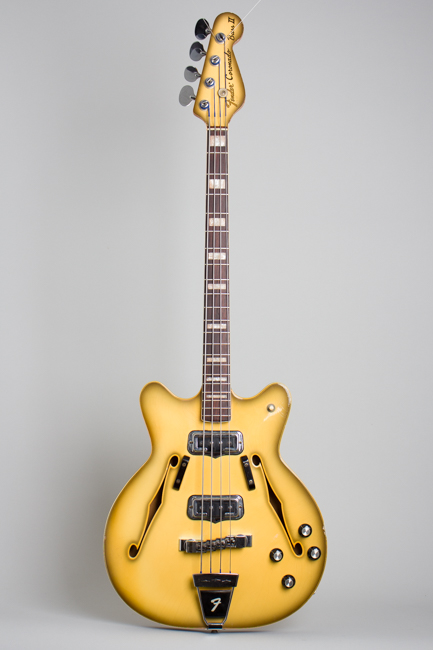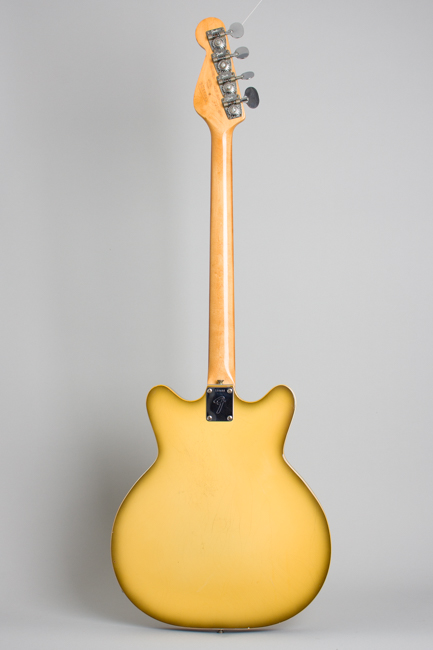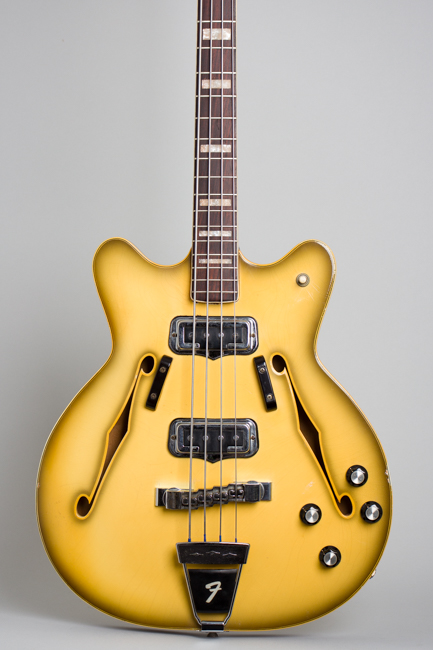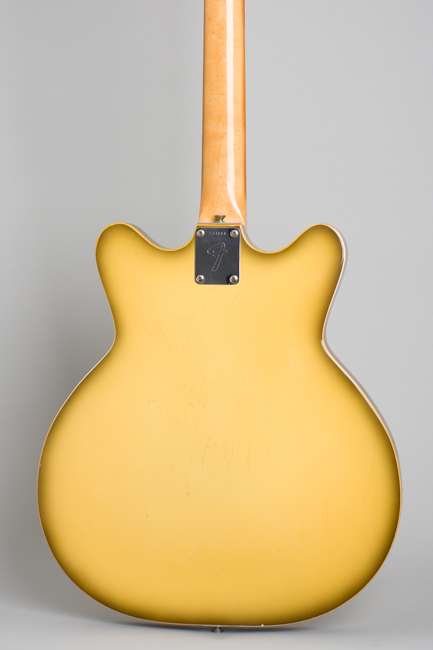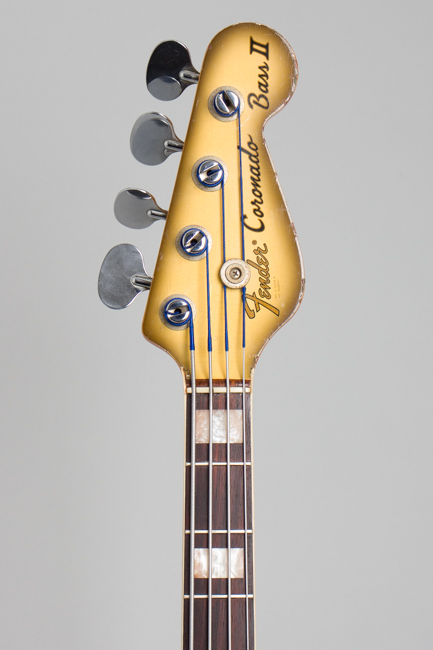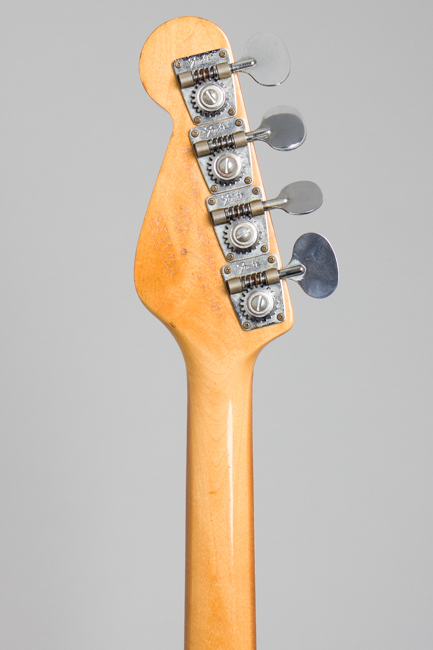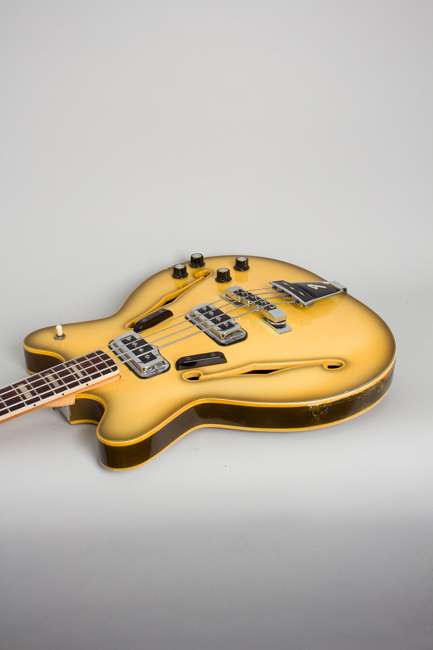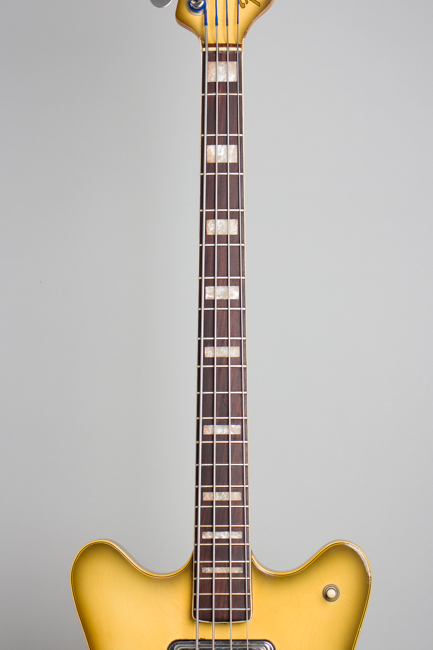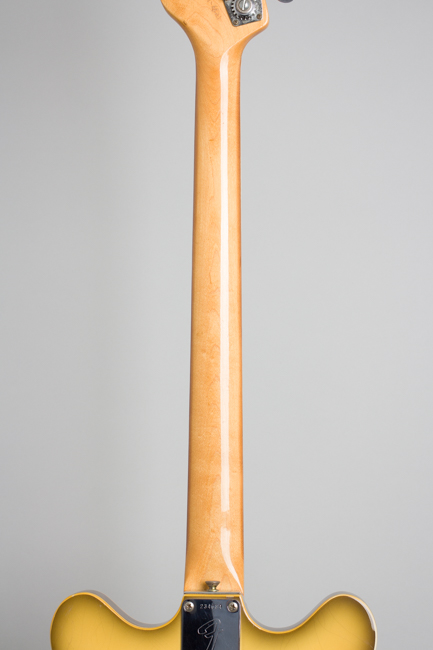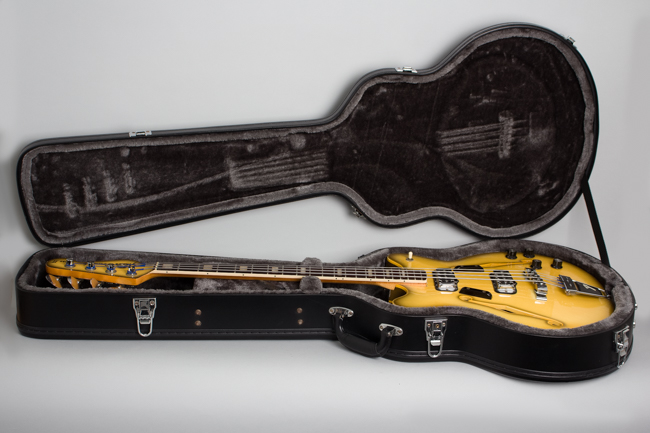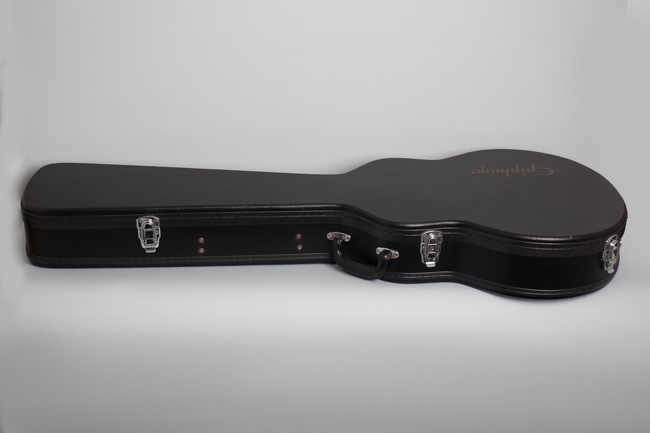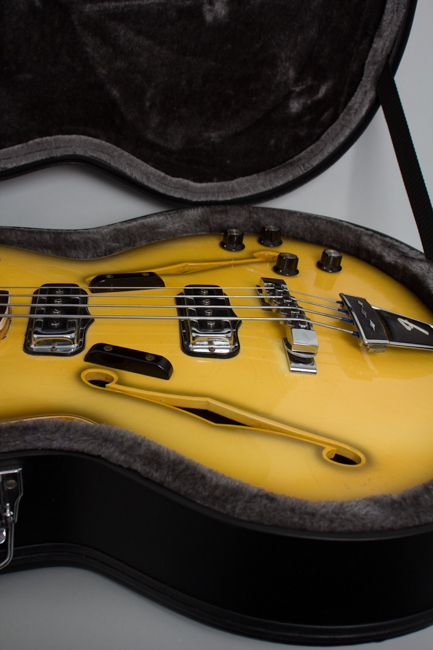Fender Coronado Bass II Antigua Hollow Body Electric Bass Guitar (1968)
This item is currently on hold.
Item # 11651
Prices subject to change without notice.
Fender Coronado Bass II Antigua Model Hollow Body Electric Bass Guitar (1968), made in Fullerton, California, serial # 234684, Antigua shaded finish, laminated maple body, maple nack with rosewood fingerboard, black tolex hard shell case.
Fender's 1960s Coronado models have always been somewhat odd ducks, and this is one of the oddest! The line was the CBS management team's project to challenge Gibson, Gretsch, and Guild in the booming 1960s hollowbody electric market. Fender's new corporate owners felt the company should cover the entire musical spectrum, not just their traditional solid body strengths. The Coronado guitar and bass line was worked up quickly, launched in January 1966 just a year after CBS bought the company. Former Rickenbacker designer Roger Rossmeisel was involved, having moved over to Fender in 1962. While not a hit at the time with either Fender loyalists or players of other brands, the Coronados remain interesting and often attractive instruments that have found some dedicated fans in the decades since.
Coronados were initially offered only in Cherry or Sunburst, but the palette was quickly expanded. This fairly rare Coronado Bass II bears a distinctive finish designed especially for the model, the unique two-tone palette Fender christened "Antigua". "Fender's latest color dimension" the 1968 catalog offered introducing the option "puts elegance in the spotlight. This inimitable new finish is a rich antique white with a halo mist shading which produces a subtle feeling of depth and dimension". It concluded "every detail...carefully prepared for a perfect blend. Be a scene stealer!"
The twin-pickup Bass II model was added to the line in 1967. It mates a 30" scale bound, block-inlaid maple/rosewood Fender bass neck to a double cutaway, fully hollow body with triple-bound edges and bound f-holes. The pickups are not Fender-made but sourced from Rowe industries, makers of the DeArmond line. They have adjustable screw poles inside a plastic center inset in the thin metal covers. The wiring is the typical Gibson style 4-knob, 1 switch array. The trapeze tailpiece has the Fender "F" in the plastic center. The bridge is a sort of staggered metal trough with adjustable plastic-center saddles on twin metal feet, one of several ideas Fender tried. There are finger rests both above and below the strings.
A twin-pickup bass listed in this Antigua livery at the then eye-popping figure of $479.50 plus $64.50 for the case. (By comparison a Custom Color Jazz bass could be had for $304!) This one has a neck date iof January 1968 and would be an early example of this special model. It is certainly striking looking, tending to divide opinions between those who marvel at its unmistakable dramatic flair and those who think it resembles cream soup left too long in the warming pan. Whatever the reaction, all can agree that it was unlike anything else Fender had attempted. Just to make it more special, the headstock matches as well. The look was also offered on matching Coronado 6- and 12-string guitars along with the Kingman flat top.
Apart from the color this is a very good-playing and sounding bass, a far better instrument than its original reputation suggests. It is very reminiscent in feel of the contemporary Harmony H-27, which has very similar features and layout but lacks the more reliable Fender neck. In its metallic mist hue this is a truly striking instrument too behold. The Coronados were discontinued after 1970; while in general they are not uncommon, this twin-pickup Antigua bass is a relatively rare example
Overall length is 45 3/4 in. (116.2 cm.), 16 1/4 in. (41.3 cm.) wide at lower bout, and 1 3/4 in. (4.4 cm.) in depth, measured at side of rim. Scale length is 30 in. (762 mm.). Width of nut is 1 9/16 in. (40 mm.).
This is a relatively clean instrument overall showing some signs of use and remaining nicely original. For the most part the finish is well preserved, with some typical checking and dings, dents and scuffing here and there. There is some shallow belt buckle scratching on the back into but not through the lacquer. The sides have the only really notable finish wear; there is an isolated spot of heavy scratching on the lower side just below the controls, with small chips extending to the top. The upper side on the lower bass bout has a larger area of scratching and what looks rather like a chemical burn; we can't say what caused this but it is confined to this one spot.
The headstock edges have some small chips and dings, the back of the neck a few small dents but no finish worn through. The original owner inscribed his personal information on the back of the headstock; apparently the bass lived in Texas for a time long ago. All hardware is original except for some reason the 4 large screws retaining the tuning gears. The chrome is mostly still quite shiny. The frets have been polished and snow some very light wear but the instrument plays perfectly, currently strung with flatwound strings. It actually has a more versatile sound than many hollow or semi hollowbody basses and is quite light and handy. This is an oddball piece of Fender history perhaps but a very playable one and a better instrument than the critics of 1968 would ever admit! It lives in a well-fitted modern HSC.
Overall Excellent - Condition.
Fender's 1960s Coronado models have always been somewhat odd ducks, and this is one of the oddest! The line was the CBS management team's project to challenge Gibson, Gretsch, and Guild in the booming 1960s hollowbody electric market. Fender's new corporate owners felt the company should cover the entire musical spectrum, not just their traditional solid body strengths. The Coronado guitar and bass line was worked up quickly, launched in January 1966 just a year after CBS bought the company. Former Rickenbacker designer Roger Rossmeisel was involved, having moved over to Fender in 1962. While not a hit at the time with either Fender loyalists or players of other brands, the Coronados remain interesting and often attractive instruments that have found some dedicated fans in the decades since.
Coronados were initially offered only in Cherry or Sunburst, but the palette was quickly expanded. This fairly rare Coronado Bass II bears a distinctive finish designed especially for the model, the unique two-tone palette Fender christened "Antigua". "Fender's latest color dimension" the 1968 catalog offered introducing the option "puts elegance in the spotlight. This inimitable new finish is a rich antique white with a halo mist shading which produces a subtle feeling of depth and dimension". It concluded "every detail...carefully prepared for a perfect blend. Be a scene stealer!"
The twin-pickup Bass II model was added to the line in 1967. It mates a 30" scale bound, block-inlaid maple/rosewood Fender bass neck to a double cutaway, fully hollow body with triple-bound edges and bound f-holes. The pickups are not Fender-made but sourced from Rowe industries, makers of the DeArmond line. They have adjustable screw poles inside a plastic center inset in the thin metal covers. The wiring is the typical Gibson style 4-knob, 1 switch array. The trapeze tailpiece has the Fender "F" in the plastic center. The bridge is a sort of staggered metal trough with adjustable plastic-center saddles on twin metal feet, one of several ideas Fender tried. There are finger rests both above and below the strings.
A twin-pickup bass listed in this Antigua livery at the then eye-popping figure of $479.50 plus $64.50 for the case. (By comparison a Custom Color Jazz bass could be had for $304!) This one has a neck date iof January 1968 and would be an early example of this special model. It is certainly striking looking, tending to divide opinions between those who marvel at its unmistakable dramatic flair and those who think it resembles cream soup left too long in the warming pan. Whatever the reaction, all can agree that it was unlike anything else Fender had attempted. Just to make it more special, the headstock matches as well. The look was also offered on matching Coronado 6- and 12-string guitars along with the Kingman flat top.
Apart from the color this is a very good-playing and sounding bass, a far better instrument than its original reputation suggests. It is very reminiscent in feel of the contemporary Harmony H-27, which has very similar features and layout but lacks the more reliable Fender neck. In its metallic mist hue this is a truly striking instrument too behold. The Coronados were discontinued after 1970; while in general they are not uncommon, this twin-pickup Antigua bass is a relatively rare example
Overall length is 45 3/4 in. (116.2 cm.), 16 1/4 in. (41.3 cm.) wide at lower bout, and 1 3/4 in. (4.4 cm.) in depth, measured at side of rim. Scale length is 30 in. (762 mm.). Width of nut is 1 9/16 in. (40 mm.).
This is a relatively clean instrument overall showing some signs of use and remaining nicely original. For the most part the finish is well preserved, with some typical checking and dings, dents and scuffing here and there. There is some shallow belt buckle scratching on the back into but not through the lacquer. The sides have the only really notable finish wear; there is an isolated spot of heavy scratching on the lower side just below the controls, with small chips extending to the top. The upper side on the lower bass bout has a larger area of scratching and what looks rather like a chemical burn; we can't say what caused this but it is confined to this one spot.
The headstock edges have some small chips and dings, the back of the neck a few small dents but no finish worn through. The original owner inscribed his personal information on the back of the headstock; apparently the bass lived in Texas for a time long ago. All hardware is original except for some reason the 4 large screws retaining the tuning gears. The chrome is mostly still quite shiny. The frets have been polished and snow some very light wear but the instrument plays perfectly, currently strung with flatwound strings. It actually has a more versatile sound than many hollow or semi hollowbody basses and is quite light and handy. This is an oddball piece of Fender history perhaps but a very playable one and a better instrument than the critics of 1968 would ever admit! It lives in a well-fitted modern HSC.
Overall Excellent - Condition.
